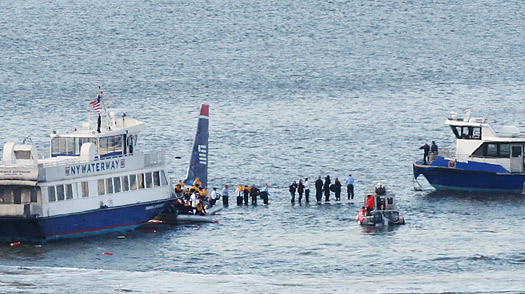Plane in the Water: How Flight 1549 Survived

On one of the coldest days of the year, a passenger jet carrying more than 150 people was forced to make a water landing in the frigid Hudson River. US Airways flight 1549, carrying 146 passengers and five crew members, crashed into waters just west of Manhattan after taking off from LaGuardia airport en route to Charlotte, North Carolina. "I was driving down 72nd Street [on the west side of Manhattan] and I saw the plane falling, falling," one eyewitness, Spiro Ketahs, told TIME. When it hit the Hudson, he said, the water gushed like a volcano. Said Adam Weiner, an employee at MTV who saw the accident from his Midtown Manhattan office building: "I was sitting in a conference room on the 39th floor, facing the window. All of a sudden I see a plane gliding into a river. At first I didn't realize what I was seeing. Then spray went up and you could tell it was a jetliner. Then a couple seconds after, the door blew off and you could see the raft blow up."
By about 3:30 p.m., news helicopters were capturing compelling images of the jet partly submerged in the water, surrounded by rescue boats and commuter ferries. Numerous emergency vehicles could be seen on the New Jersey shore, responding to the incident. By 4 p.m., the plane had sunk into the frigid waters. MSNBC reported that the pilot had radioed air traffic controllers shortly after takeoff to say that the plane had collided with a flock of geese. Losing altitude, the pilot reportedly opted for a water landing. A survivor told reporters that he was sitting next to the wing when the engine exploded and the pilot announced, "Brace yourself, we're going down."
What are called "bird and wildlife strikes" have caused hundreds of millions of dollars in damage to U.S. civil and military aviation over the years, as well as loss of life. Says Todd Curtis, founder of Airsafe.com and an expert in aviation service: "The risk is real. Birds are a threat every day, but only on rare occasion do you have them causing a crash." He explains that an Airbus A320, the type of plane involved in the crash, has an engine designed to sustain damage from up to a four-pound bird. "The real hazard is if you have simultaneous damage with a flock of birds. I don't know what happened in this case, but multiple engine failure due to bird strikes can bring an aircraft down."
By a little after 5 p.m., the plane had been towed to the Manhattan shoreline. Though crew members reportedly said that all passengers exited the plane before it sunk, officials were waiting on a final head count before confirming that. Said Weiner, the eyewitness: "You could see the [rescue] boats got there in two minutes. You could see, it looked like the people were getting off and onto the boat."
The accident appears to have had a much better outcome than many similar incidents in U.S. aviation history. In January 1982, an Air Florida flight crashed into the Potomac in Washington, D.C. That plane was not fully de-iced on a 24 degree day; only about five people survived the incident, in part because it took a while for rescue vehicles to get to the plane in the cold water.
In this case, the landing and the quick response of the rescuers appear to have worked in the favor of survivors. Says Weiner: "It seemed like the plane was really in control as it came into the river. It was almost as if the river was like the runway. It was approaching it like it was a runway until it hit the water, and then you didn't know what to expect. Thank God it stayed in one piece and just slid along its belly."
Airplane crashes have become rare in the U.S. and water landings even rarer. Says Amanda Ripley, a former TIME writer and the author of The Unthinkable: Who Survives When Disaster Strikes: "All the instructions they tell you to do, taking the life vests from your seat, grabbing a cushion as a flotation device, are all very difficult to follow in that kind of a landing. Hitting the water is incredibly jarring. It is quite an impact. Many people may black out." Adds Ripley: "The plane sinks quickly. You have to recover from the shock, unbuckle your seat belt and get up and out of the cabin. There is very little time to react. That is the challenge."
With reporting by Steve Snyder, Vanessa Kaneshiro, M.J. Stephey and Howard Chua-Eoan / New York
Top Stories on Time.com
Most Popular »
-
Most Read
- First Rule of the Ant Colony: No Hanky-Panky
- Study: A Simple Surgery Checklist Saves Lives
- The Perils of Being a Good Samaritan in California
- Should Students Be Paid for Good Grades?
- Fighting the Media War in Gaza
- Obama's Other Breakthrough: A Big-City President
- The 'Green' Revolution in Cars Dies Off
- The Mystery of Borderline Personality Disorder
- Old Nazi News Makes Headlines in Germany
- Facebook Users Go to War over Gaza
-
Most Emailed
- The Mystery of Borderline Personality Disorder
- First Rule of the Ant Colony: No Hanky Panky
- Subaru: A Rare Bright Spot Amid Automakers' Gloom
- How to Understand a Trillion-Dollar Deficit
- Suffocating in Snuggies: That Ubiquitous TV Ad
- Fifty Years of Motown
- America's Untapped Energy Resource: Boosting Efficiency
- The Bush Administration's Most Despicable Act
- Palm Beach: The New Capital of Florida Corruption
- Can Israel Survive Its Assault on Gaza?
 Mixx
Mixx









 RSS
RSS